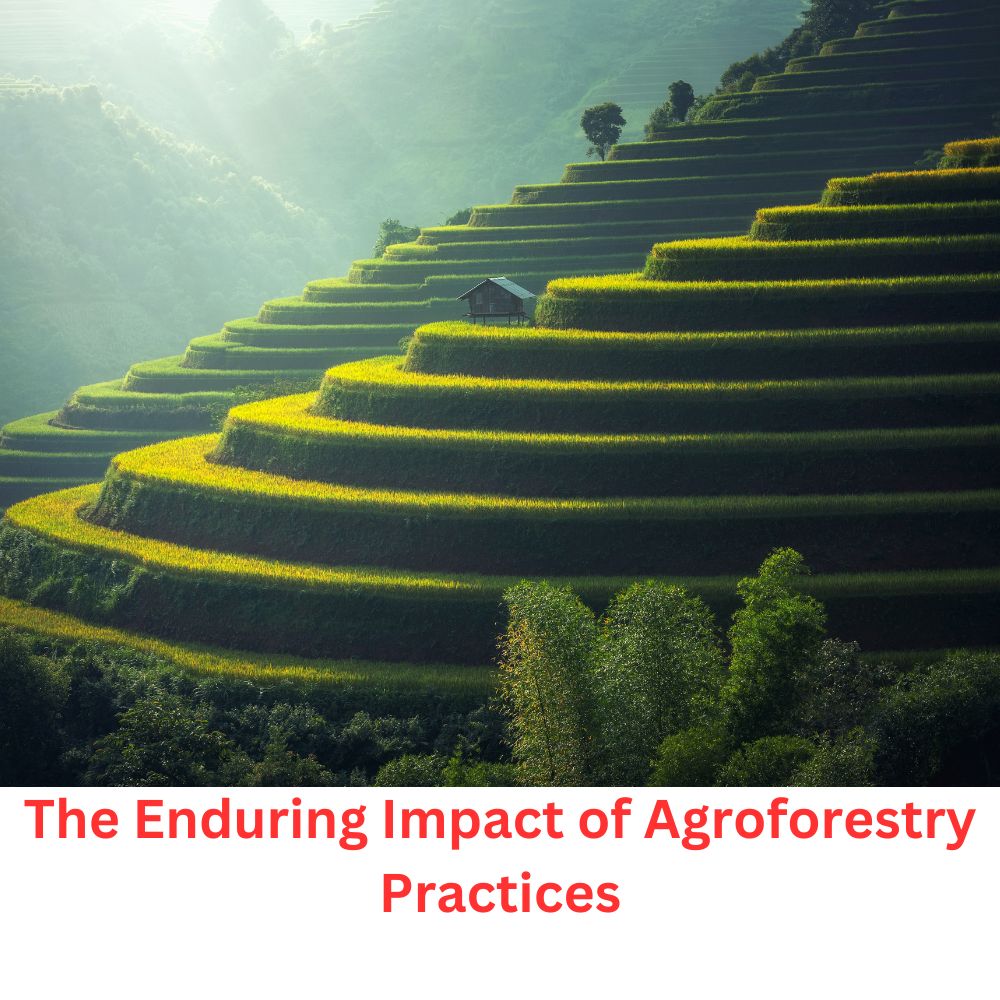Introduction
Agroforestry, the integration of trees and shrubs into crop and livestock farming systems, stands as a testament to sustainable agriculture, offering solutions to environmental, economic, and social challenges. This 1500-word article explores the enduring impact of agroforestry practices, tracing their roots from traditional knowledge to modern applications and highlighting their long-term benefits for ecosystems, communities, and global health.
Historical Roots of Agroforestry
Agroforestry is not a new concept; it has been practiced for centuries across various cultures. Traditional agroforestry systems like the ‘Dehesa’ in Spain, ‘Shamba’ in East Africa, and the ‘Homegardens’ in South Asia have long demonstrated the symbiotic relationship between trees and agricultural landscapes. Based on indigenous knowledge, these systems have sustained communities by providing food, shelter, and economic stability.
Environmental Benefits
The environmental impacts of agroforestry are profound and long-lasting. Trees in these systems contribute to soil health through nutrient cycling, reducing erosion, and improving water retention. Biodiversity is another significant benefit, as agroforestry systems support a variety of flora and fauna, contributing to habitat connectivity and wildlife conservation.
- Carbon Sequestration: Agroforestry’s role in carbon sequestration is critical in the fight against climate change. Trees in agroforestry systems absorb carbon dioxide, helping to mitigate greenhouse gas emissions.
- Water Conservation: Agroforestry practices enhance water conservation. Tree roots help to percolate into the soil, replenish nutrients, and reduce soil erosion.
Economic Resilience and Diversification
Agroforestry contributes significantly to economic resilience. By diversifying farm production, it provides farmers with multiple income streams. Integrating trees with crops and livestock reduces the risk of crop failure and ensures a steady supply of various agricultural products.
- Income Diversification: Farmers benefit from selling timber, fruits, nuts, and medicinal plants alongside traditional agricultural products.
- Sustainable Livelihoods: Agroforestry supports sustainable livelihoods, especially in rural areas, where it provides employment and combats poverty.
Social and Cultural Dimensions
Agroforestry practices are deeply intertwined with the social and cultural fabric of communities. They preserve traditional agricultural knowledge and practices, fostering community spirit through shared resources and cooperative farming.
- Community Development: Agroforestry encourages community participation and development. The collective management of resources fosters a sense of community ownership and responsibility.
- Cultural Heritage: Many agroforestry practices are part of cultural heritage, preserving indigenous knowledge and biodiversity.
Adaptation to Climate Change
Agroforestry is a critical strategy in adapting to climate change. The diversification of crops and tree species in agroforestry systems provides a buffer against climate extremes, ensuring food security and livelihoods in changing environmental conditions.
- Resilience to Climate Extremes: Agroforestry systems are more resilient to climate extremes such as droughts, floods, and heat waves.
- Risk Mitigation: The diversification of species and income sources in agroforestry reduces the risk of climate-induced crop failures.
Policy and Institutional Frameworks
The success and sustainability of agroforestry practices depend on supportive policy and institutional frameworks. Governments and international organizations need to recognize the value of agroforestry in sustainable land management and integrate it into agricultural and environmental policies.
- Policy Support: Policies that support agroforestry, such as subsidies, technical assistance, and market access, are crucial for its widespread adoption.
- Research and Development: Continued research and development in agroforestry practices are essential for optimizing their benefits.
Challenges and Future Directions
While agroforestry has numerous benefits, it faces land tenure issues, initial investment costs, and a need for more awareness. Addressing these challenges requires a multi-faceted approach involving education, capacity building, and policy reforms.
- Education and Awareness: Raising awareness about the benefits of agroforestry and providing education on its practices is critical to its broader adoption.
- Innovative Solutions: Future research should focus on innovative agroforestry practices that are more efficient, productive, and adaptable to different ecological conditions.
Case Studies and Global Impact
The article highlights several case studies from around the world where agroforestry has significantly impacted. These include the success of silvopastoral systems in Latin America, agroforestry initiatives in sub-Saharan Africa that have improved soil fertility, and agroforestry projects in Southeast Asia that have enhanced biodiversity and economic resilience.
The Role of Technology and Innovation
Technology and innovation play a crucial role in advancing agroforestry practices. Remote sensing, GIS mapping, and drone technology can be used for monitoring and managing agroforestry systems. Innovations in tree breeding and cultivation techniques can also enhance the efficiency and productivity of agroforestry systems.
Community Engagement and Empowerment
Successful agroforestry initiatives are often grounded in strong community engagement and empowerment. Involving local communities in the planning, implementing, and managing of agroforestry projects ensures their sustainability and relevance to local needs.
Conclusion
Agroforestry stands as a beacon of sustainable agriculture, offering solutions to some of our time’s most pressing environmental, economic, and social challenges. Its ability to balance agricultural productivity and ecological conservation makes it an essential strategy for a sustainable future. As we move forward, the legacy of agroforestry will continue to grow, rooted in the principles of sustainability, resilience, and community harmony.
This article provides a comprehensive overview of the enduring impact of agroforestry practices. It explores agroforestry’s historical roots, environmental benefits, economic resilience, and social and cultural dimensions while addressing the challenges and future directions for this sustainable agricultural practice. Through case studies and a focus on policy and community engagement, it highlights the significant role of agroforestry in shaping a sustainable future.
